Traceability
All Posts & News Press Releases Success Stories Aftercare Editorials Retraining Tips Supporter Features Inspector Spotlights Humberger Toggle Menu Previous Post The Importance of Traceability in Thoroughbred Racing & Aftercare This article was originally featured in the July 2024 Issue of BloodHorse Magazine in the Second Acts series. This article is the original format and text. To read the BloodHorse article or to subscribe click HERE. The Importance of Traceability in Thoroughbred Racing & Aftercare By: Samantha Smith September 11, 2024 Aftercare Editorials Tags:BloodHorse Magazine, Equine Safety, Equine Welfare, Horse Inventory, The Jockey Club, Thoroughbred Aftercare, Thoroughbred Aftercare Alliance, Traceability Mom’s Reward pictured taking a nap. Tracking a horse’s information and whereabouts throughout its life, known as traceability, is indispensable in horse racing. It’s vital for equine welfare, industry integrity, and accountability. In North American Thoroughbred racing, traceability is essential from birth to post-racing but poses persistent challenges. Effective inventory control should be a priority, reducing uncertainty about Thoroughbreds’ whereabouts. Thoroughbred Aftercare Alliance mandates inventory reports from accredited organizations, although only after horses reach these facilities. Thoroughbred Aftercare Alliance consulted with various racing professionals, gaining insights into traceability challenges and perspectives across the industry. Jill’s Story: A Breeders’ Quest for Traceability and Accountability Jill Pritchard, a dedicated equestrian and breeder, emphasizes the importance of traceability in racing. Her firsthand experiences underscore the challenges breeders face in ensuring the welfare and whereabouts of their horses. Jill shares both positive and negative anecdotes, illustrating where challenges beyond her control persist and improvements can be made. Despite her best efforts, she couldn’t trace some foals after selling them as yearlings, reflecting broader industry challenges in ensuring Thoroughbred welfare and whereabouts. Mom’s Reward pictured as a foal. Photo Credit: Amy Lanigan. Mom’s Reward Mom’s Reward is a tragic example of a horse lost in the system. A 2021 filly by Preservationist out of Ventoux. After her sale, the filly never had a published workout, let alone raced. Despite Jill’s attempts to contact the trainer, she received no response. Eventually, Jill learned that Mom’s Reward was euthanized due to a breakdown in training, though this information remains unconfirmed. The lack of traceability and communication left Jill feeling helpless. Unable to confirm the horse’s fate or reach the trainer, she could do nothing to assist Mom’s Reward. Kicksandgiggles pictured at the sales. Kicksandgiggles Kicksandgiggles, trained by Jeff Hiles, stands out as a success story amid the challenges of traceability. Kicksandgiggles is a 2020 gelding by Bernardini out of Driving Rain. Thanks to the help of Buff Bradley, Jill was able to connect with the trainer when she sold him as a yearling and maintain communication with Jeff Hiles throughout the horse’s career. Jill was able to get the horse back when Jeff was ready to retire him, and ensured he transitioned into training for a second career. Today, Kicksandgiggles lives happily with his new owner in Minnesota, a testament to the importance of open communication and accountability in ensuring the welfare of Thoroughbreds beyond the racetrack. Bottle Rocket Bottle Rocket, a 2012 colt by Intense Focus out of Shoes to Match, was sold as a weanling for $5,500 and went on to win over $226,000. His first owner and trainer kept Jill updated on his progress, but after he was claimed and moved out West, communication became difficult. Eventually, Jill learned from a trainer that Bottle Rocket was retired to the owner’s farm after his last race at Del Mar. Over two years later, he resurfaced at a Quarter Horse meet in Los Alamitos. Despite her best efforts, including speaking with the track steward and reaching out on social media through the Posse Foundation and various Thoroughbred groups, Jill was unable to get any updates from his connections or determine his whereabouts after his last race in January 2020. Kicksandgiggles as a foal with his mother. Kicksandgiggles playing in the field. Kicksandgiggles as a foal. Jill with Mom’s Reward. Mom’s Reward taking a nap. The Registration Process The Jockey Club is the breed registry for North American Thoroughbreds, and it outlines the eligibility rules and requirements for a foal to become a registered Thoroughbred. Since 2017, the implant and reporting of a microchip has been a condition of registration, and in 2018 Digital Certificates of Foal Registration were introduced, replacing traditional paper documents. Both initiatives were aimed at improving identification tools for Thoroughbreds, but also to enhance means of traceability. While these measures have been a welcome development for the Thoroughbred industry, the responsibility of updating ownership still lies primarily upon individual stakeholders. Best practices would see ownership being updated to The Jockey Club each time a horse is transferred, but compliance isn’t guaranteed. Beyond Racing Once a Thoroughbred’s racing career ends, tracking its post-racing journey can be additionally challenging. While the breed registry does not mandate reporting a horse’s retirement, a process is available through The Jockey Club, called Transferred as Retired from Racing, that enables an owner to retire a Thoroughbred from racing without affecting its breeding privileges. If a Transferred as Retired from Racing Thoroughbred is entered at a North American racetrack, racing officials are electronically notified that the horse is retired. In addition, it is free to transfer ownership of a Thoroughbred using The Jockey Club Registry’s Interactive Registration at registry.jockeyclub.com. In addition, once a horse makes it to a Thoroughbred Aftercare Alliance-accredited facility, there are mandatory requirements in place for reporting and managing horse inventory. “Thoroughbred Aftercare Alliance mandates inventory reports from all accredited organizations four times annually,” said Suzie Oldham, Thoroughbred Aftercare Alliance, Inspections Administrator. “This meticulous approach ensures that horses at each of the organization’s facilities are registered Thoroughbreds creating a traceable record of horses passing through the program and offering peace of mind to previous owners who may be seeking their equine companions.” Conclusion From birth to retirement, every horse deserves a clear and accountable journey. With industry-wide initiatives and advancements in technology, the goal of comprehensive traceability is within reach. As The Jockey Club’s traceability initiative
Read More >













